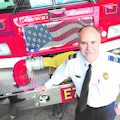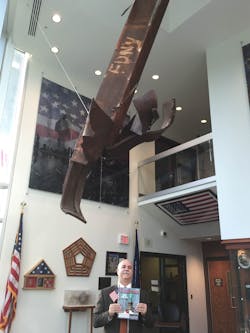My first recollection of Firehouse Magazine was in the station of Harrisonburg, VA, Fire Station #1 when I was a volunteer firefighter with Harrisonburg Fire Company #1. I remember when it came in the mail; everyone was trying to get their hands on it. I had already read Dennis Smith’s book Report from Engine Company 82, and I, like many others, were interested to see his new magazine. Fast-forward many years to September 2015, when I retired from the Charlottesville Fire Department, I carefully packed up my office and stored my copy of the Firehouse Magazine charter issue into a box for safe-keeping.
My journey with Firehouse Magazine started with the Internet. After designing the Charlottesville Fire Department's website back in 1995, it was very apparent to me that the Internet would have a significant influence on the fire service and public safety. When the Charlottesville Fire Department's website was posted on the World Wide Web, the Internet was still in its infancy, and there were less than 100 fire service websites on the Internet.
Realizing the potential of the Internet, I submitted an article via the U.S. Postal Service (snail mail, as we now know it today) to several fire service trade magazines (which you are not supposed to do) with a first-come, first-serve note. Surprisingly and excitedly, I received a request for the article from Editor-in-Chief Harvey Eisner. And as a result, I was the lead author for the first fire service article on the Internet in Firehouse Magazine—“The Internet: A Global Fire Service,” June 1996 issue.
Following that article, I became friends with Harvey and another editor, Jeff Barrington, and was asked to serve as a contributing editor for Firehouse Magazine on technology-related articles, and to be a presenter at a number of Firehouse Expo conferences in Baltimore. My life would never be the same.
After observing the development of the Internet and other related applications, such as email and file transfers, I had numerous discussions with Harvey and Jeff about the implementation of email and a website for Firehouse. While Harvey and Jeff were in full agreement, it wasn't until late-1998/early-1999 that the corporate approval had come, for email first, then followed by the website (later to become Firehouse.com).
Email made it easier to communicate with the staff, send articles and upload graphics. Shortly thereafter, I was given the green light to bring a concept for a Firehouse Magazine website. I had started a column in Firehouse called Hot Spots on the Web, which became one of the first interactive features of Firehouse.com, and had run across the Hyattsville, MD, Fire Department website and was so impressed with it that I called Dave Iannone on the phone one Friday afternoon. I vividly remember that conversation as I introduced myself and asked, “How would you like to do a website for Firehouse Magazine?” Dave thought I was joking, laughed and then asked me if I was serious. After a long pause and time for thought, he asked me what I was looking for and when did I need it. I explained that I needed a website with the look and feel of Firehouse Magazine and the deadline was by Monday morning (remember this was on Friday afternoon). Dave then said, “No thanks,” and our conversation ended. Several hours later, I received another call from Dave, who simply said, "Go to this url ….” I turned on my computer, went to the website and, to my surprise, I saw the then-cover of Firehouse Magazine in a website design—and the concept of Firehouse.com was born. In early 1999, I had the honor of writing the introductory article titled "Firehouse Launches The Premier Emergency Service Website!” Firehouse.com became, and to my knowledge remains, the most popular fire service website in the world.
At that time, the Internet was still in its infancy for the emergency service community, and as I recall, the number of fire service websites had grown from less than 100 in 1995 to more than 5,000 in 1999 to more than 30,000 in 2009. And referring back to my original article, the Internet has truly realized the concept of a global fire service, as fire department websites are commonplace, along with Facebook, Twitter, Tumblr, blogs, YouTube and other social media programs.
In general, websites were fairly static with simple graphics, basic links and sometimes an email address, and were accessible via a low-speed telephone modem. For the most part, websites were a simple way to establish an Internet presence and a way to tell about a company/organization with pertinent location and contact information. Websites quickly began to evolve with more interactive features, such as chat rooms and forums, and Firehouse.com provided some of the first and most comprehensive forums for the emergency service community.
As I began to write more articles, sharing the experiences of what was being done in my fire department and what I knew with others, I quickly began to receive phone calls requesting information, hundreds of emails, interviews for national news agencies, requests for applied research papers and additional requests to present all over the United States. My articles had the primary theme of new technology, covering such topics as the Internet, free email for fire departments, developing fire department websites, free website hosting, interoperable public safety communications, Nextel Direct Connect, computers in the fire service, geographic information systems (GIS), thermal imaging cameras, geo-positioning satellites (GPS), the Microsoft Technology Summit, developing online standard operating guidelines, technology and terrorist activity, developing social media policies, fire service computer-aided dispatch (CAD), Y2K, emerging broadband wireless technology, LTE, technology for firefighter accountability, satellite communications, virtual meetings, webinars and collaboration, 700-MHz radio spectrum and the “D” Block, iPhones, iPads, Androids, smartphones and tablets. The most recent technology article series includes unmanned aircraft systems (drones).
Firehouse encouraged me to share information to the fire service about the activities of the organizations that I served on or worked with closely such as the National Public Safety Telecommunications Council (NPSTC), the National Alliance for Public Safety GIS Foundation, the Department of Homeland Security (DHS) SAFECOM Executive Committee, the National Information Sharing Consortium (NISC), the FirstNet Public Safety Advisory Committee (PSAC), the International Association of Fire Chiefs (IAFC) Technology Council, the IAFC Digital Noise Working Group, the DHS Office of Emergency Communications, FEMA, DHS Science and Technology, the White House/DHS Incident Management Information Sharing Sub Committee among others. These articles informed fire service personnel about what services they provided and links on how to take advantage of opportunities to become involved.
Firehouse also afforded me to write interview articles on some of the most prominent fire service/public safety leaders in the country to give the fire service an up-close-and-personal look at key people, such as DHS Domestic Preparedness Director Sue Mencer; Congressman Curt Weldon; DHS Science & Technology Director Dr. David Boyd; U.S. Fire Administrators David Paulison, Greg Cade and Kelvin Cochran; DHS Office of Emergency Communications Deputy Director Chris Essid; National Fire Academy Superintendent (now U.S. Deputy Fire Administrator) Denis Onieal; DHS Science and Technology Director Dr. Robert Griffin; FCC Chairman Michael Powell; FCC Homeland Security Chief Derek Poarch; FCC Public Safety Bureau Chief James Barnett; Washington, D.C. Fire Chief Dennis Rubin; FEMA Administrator Craig Fugate; and Fire Chief (ret.) and FirstNet Vice Chair Jeff Johnson.
In addition to the informative nature of Firehouse Magazine on so many fronts, perhaps one of the most important was that of public safety advocacy. Firehouse supported articles that would improve the fire service, from political insights, awareness, an occasional call to action or simply support of specific organizations or initiatives. I was able to write articles that supported the fundraising efforts of the National Fallen Firefighters Foundation (NFFF) and the 9/11 Tribute Center. The 9/11 Tribute Center article introduced me to Lee Ielpi, a retired FDNY firefighter whose son, FDNY Firefighter Jonathan Ielpi (Squad 288) died on 9/11. This relationship would have a profound effect on me and the Charlottesville Fire Department, as it led to our gift of 9/11 Memorial Steel, which is now suspended from the ceiling in CFD Station 10. I wrote about the trip to JFK Hangar 17 to take possession of the Memorial Steel in the September 2011 issue. It was an experience that I will never forget, and I had the chance to share it with Firehouse Magazine’s readers.
Also, when there were issues in which I was personally engaged, Firehouse was there to amplify the fire service voice and encourage action. Articles on action included public safety radio interference and rebanding, FCC narrowbanding, issues with the National Fire Incident Reporting System (NFIRS), issues with fire service digital noise, and prominently supported the position on the “D” Block and FirstNet. The impact was phenomenal on these issues, as it inspired firefighters across the nation to get involved and reach out and share fire service needs with their elected officials.
Like so many, Harvey Eisner, Jeff Barrington and Firehouse Magazine opened a door that took a fire service captain from the fire station in Charlottesville, VA, and propelled him into the national spotlight and introduced him to a network of influential leaders. Through articles, forums and Firehouse Expo speaking opportunities, I have met some of the most impressive fire service leaders of our time and had the honor to work with them on some very important endeavors. In 2008, I was honored to receive the National Career Fire Chief of the Year Award, which was undoubtedly influenced by the remarkable journey, which began with Firehouse Magazine. I am forever grateful for the opportunities, the collective accomplishments and the friendships that Firehouse Magazine and its leadership have afforded me. As in the past, Firehouse Magazine’s future is bright and will inform, educate and entertain another generation of firefighters. The current leadership of Tim Sendelbach and the Firehouse staff ensures success. Stay tuned, there’s much more to come from Firehouse and me!
About the Author

Charles Werner
CHARLES WERNER, who is a Firehouse contributing editor, is a 45-year veteran of public safety. He served with the Charlottesville, VA, Fire Department for 37 years, serving the past 10 years as chief. Following retirement, Werner served for two years as senior adviser and acting deputy state coordinator for the Virginia Department of Emergency Management. He has chaired: DHS SAFECOM Executive Committee; IAFC Technology Council; National Information Sharing Consortium; and DHS/White House Incident Management Information Sharing SubCommittee. Werner currently serves as the director of DroneResponders Public Safety Alliance, chair of the National Council on Public Safety UAS and chair of the Virginia Secure Commonwealth UAS Sub Panel.
